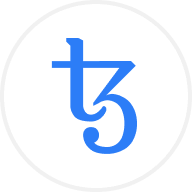Tezos (XTZ): Navigating Volatility, Innovations, and Future Prospects
Tezos (XTZ) Price Analysis: History, Trends, and Future Outlook
Tezos Price History and Performance
Tezos (XTZ) has been a notable player in the cryptocurrency market, characterized by significant price volatility since its inception. The token reached its all-time high of $9.18 in October 2021, fueled by a bullish market cycle and growing interest in decentralized applications (dApps) and non-fungible tokens (NFTs). However, as of now, XTZ trades within the range of $0.56–$0.77, reflecting broader market downturns and macroeconomic pressures.
The price of XTZ is influenced by external factors such as inflation, Federal Reserve monetary policies, and geopolitical events like the Russia-Ukraine conflict. These elements have created a challenging environment for cryptocurrencies, including Tezos, as investors adopt a risk-averse approach.
Technical Analysis of XTZ
From a technical perspective, Tezos has recently shown signs of breaking out of a long-standing descending trendline. Key resistance levels are identified at $0.80–$0.85, while support is observed at $0.7179. Traders often rely on tools like Simple Moving Averages (SMA), Exponential Moving Averages (EMA), Relative Strength Index (RSI), and Moving Average Convergence Divergence (MACD) to analyze XTZ's price trends.
Relative Strength Index (RSI): Indicates whether XTZ is overbought or oversold.
Fibonacci Retracement Levels: Provide insights into potential price targets.
MACD: Helps identify momentum shifts and trend reversals.
These tools are essential for navigating the inherent volatility of Tezos and other cryptocurrencies.
Unique Features of Tezos
Tezos distinguishes itself from competitors like Ethereum and Solana through its innovative on-chain governance model. This mechanism allows token holders to vote on protocol upgrades, eliminating the need for hard forks and ensuring seamless network evolution. Additionally, Tezos employs a Proof-of-Stake (PoS) consensus mechanism, which is more energy-efficient compared to Proof-of-Work (PoW) models used by older blockchains like Bitcoin.
The platform's self-amending nature ensures adaptability to technological advancements without disrupting the ecosystem. This flexibility has made Tezos a preferred choice for developers building decentralized applications and financial products.
DeFi and NFT Developments on Tezos
Tezos has made significant strides in the decentralized finance (DeFi) and NFT sectors. Recent innovations, such as the Etherlink Layer 2 solution, have enhanced scalability and reduced transaction costs, making the platform more attractive for developers and users alike.
Total Value Locked (TVL): Tezos' DeFi ecosystem has grown by 8%, reaching $45.43 million.
NFT Adoption: The eco-friendly PoS model has attracted artists and collectors who prioritize sustainability.
These developments underscore Tezos' commitment to fostering growth in emerging blockchain sectors.
Market Sentiment and External Factors Affecting XTZ Price
Market sentiment around Tezos is shaped by a combination of internal developments and external factors. Innovations like Etherlink and partnerships with major brands have bolstered confidence, while challenges such as lawsuits and internal conflicts have dampened investor trust.
Macroeconomic conditions, including inflation and interest rate hikes, also play a significant role in influencing XTZ's price. Regulatory changes could further impact Tezos' adoption and valuation as the cryptocurrency market matures.
Institutional Interest and Partnerships
Institutional interest in Tezos is growing, driven by its innovative approach to tokenized assets. Products like those from Mida showcase Tezos' potential in creating secure and efficient financial instruments. Additionally, partnerships with high-profile organizations, such as collaborations for digital collectibles, highlight the platform's efforts to drive mainstream adoption.
These partnerships not only enhance Tezos' visibility but also demonstrate its utility in real-world applications, from sports to art and beyond.
Challenges Faced by Tezos
Despite its strengths, Tezos has faced several challenges over the years. Lawsuits and internal power struggles have created uncertainty, affecting investor confidence and price performance. Moreover, the platform competes with more established blockchains like Ethereum, which dominate the market for dApps and DeFi.
Addressing these challenges will be crucial for Tezos to maintain its relevance and attract new users and developers.
Future Price Predictions for XTZ
Price predictions for Tezos vary widely, reflecting the cryptocurrency market's inherent uncertainty:
Optimistic Forecasts: Suggest XTZ could reach as high as $14.78 by 2031, driven by increased adoption and technological advancements.
Bearish Predictions: Warn of potential declines if market conditions worsen or if Tezos fails to address its challenges.
Long-term predictions are speculative and depend on factors such as market sentiment, regulatory developments, and the platform's ability to innovate.
Comparison with Competitors
Tezos competes with major blockchains like Ethereum and Solana in the dApp, DeFi, and NFT spaces:
Ethereum: Benefits from its first-mover advantage and extensive developer community.
Solana: Known for its high throughput and low transaction costs.
Tezos: Offers unique features like on-chain governance and a sustainable PoS model.
The choice between these platforms often depends on the specific needs of developers and users.
Tezos' Role in Decentralized Finance and Applications
Tezos continues to play a significant role in the evolution of decentralized finance and applications. Its focus on scalability, security, and sustainability makes it a compelling option for developers and enterprises. As the blockchain ecosystem grows, Tezos' ability to adapt and innovate will determine its long-term success.
Conclusion
While Tezos faces challenges, its unique features and ongoing developments position it as a noteworthy player in the cryptocurrency space. Investors and developers alike should keep an eye on this evolving platform as it navigates the complexities of the blockchain industry.
© 2025 OKX. This article may be reproduced or distributed in its entirety, or excerpts of 100 words or less of this article may be used, provided such use is non-commercial. Any reproduction or distribution of the entire article must also prominently state: “This article is © 2025 OKX and is used with permission.” Permitted excerpts must cite to the name of the article and include attribution, for example “Article Name, [author name if applicable], © 2025 OKX.” Some content may be generated or assisted by artificial intelligence (AI) tools. No derivative works or other uses of this article are permitted.



